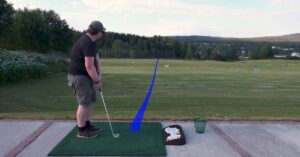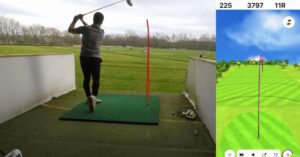What Is Ball Striking In Golf: Mastering The Fundamentals
Ball striking in golf refers to the ability to consistently hit the golf ball with the club’s sweet spot, resulting in accurate shots with proper distance, trajectory, and spin. It’s a crucial skill for golfers to achieve consistent and successful play on the course.
Mastering the art of ball striking requires a combination of proper technique, balance, and timing. In this blog post, we will delve deeper into the essential aspects of ball striking and explore tips to help you improve your game on the greens.
How Do You Calculate Ball Striking In Golf?
Ball striking in golf is the skill of consistently making solid contact with the golf ball. Improving ball striking leads to better accuracy, distance, and overall performance on the course.
To calculate ball striking, focus on the following steps.
Develop A Consistent Swing
A proper golf swing is essential for consistent ball striking. Work on maintaining a smooth and repeatable swing motion to improve your chances of striking the ball consistently.
Establish Proper Setup
Ensure your setup is correct by positioning your feet, hips, and shoulders parallel to the target line. Maintain a balanced stance with your weight evenly distributed between both feet.
Align Your Clubface
At address, make sure the clubface is square to the target. Proper alignment ensures that your shots start on the intended line, which is crucial for accurate ball striking.
Maintain A Steady Head
During the swing, focus on keeping your head relatively still. Excessive movement can lead to inconsistent strikes. A steady head allows you to maintain your swing plane and make solid contact with the ball.
Achieve Proper Impact Position
The impact position is critical for effective ball striking. At impact, your hands should be ahead of the clubhead, ensuring a downward strike on the ball. Practice hitting crisp iron shots with a proper impact position.
Develop Clubhead Speed
Generating clubhead speed is important for powerful ball striking. Work on improving your swing tempo, sequencing, and rotational speed to maximize your clubhead speed.
Practice With Different Clubs
Ball striking can vary depending on the club you are using. Practice with different clubs to develop a feel for each one and adjust your swing accordingly.
Analyze And Adjust
Regularly review your ball striking performance and make necessary adjustments. Seek feedback from a golf instructor or use technology such as launch monitors to analyze your swing and make improvements.
Play With Focus And Confidence
Ball striking is not only about technique but also mental focus and confidence. Stay committed to your shots, trust your swing, and maintain a positive mindset to enhance your ball striking abilities on the course.
How Do You Practice Golf Ball Striking?
To improve ball striking, focus on grip, posture, alignment. Practice dedicatedly for longer drives, accuracy, and consistency.
Follow these steps to develop a solid foundation and become a more consistent and effective ball striker.
Step 1: Establish the Correct Grip
The first step in practicing ball striking is to ensure you have the correct grip on the club. Place your left hand on the club, positioning it diagonally across your fingers and palm.
Then, interlock your right pinky finger with the index finger of your left hand. This grip promotes control and allows for better transfer of power through the swing.
Step 2: Focus on Proper Posture
Maintaining a proper posture is crucial for optimal ball striking. Stand with your feet shoulder-width apart and your knees slightly flexed. Bend forward from your hips, keeping your back straight.
Your arms should hang naturally, allowing for a comfortable and balanced stance. This posture facilitates a fluid swing and helps generate power and accuracy.
Step 3: Align Your Body and the Clubface
Proper alignment is essential to strike the ball with precision. Aim your feet, hips, and shoulders parallel to the target line. Align the clubface square to the target as well.
This setup allows for a consistent swing path, ensuring that the clubface strikes the ball squarely, resulting in a straighter shot.
Step 4: Practice Tempo and Timing
To develop a consistent ball striking technique, it’s crucial to work on your tempo and timing. Focus on maintaining a smooth and controlled swing throughout the entire motion.
Avoid rushing or decelerating the clubhead during the downswing. A rhythmic and well-timed swing promotes solid contact with the ball and maximizes distance and accuracy.
Step 5: Implement Targeted Drills
Incorporating targeted drills into your practice routine can help refine your ball striking skills.
Practice hitting balls with a specific goal in mind, such as hitting low shots, shaping your shots, or improving your distance control.
These drills allow you to focus on specific aspects of your game and develop the necessary muscle memory for consistent ball striking.
Step 6: Analyze and Adjust
Regularly assess your ball striking performance to identify areas that require improvement.
Utilize video analysis or seek the guidance of a golf professional to evaluate your swing mechanics.
Based on the feedback, make adjustments to your grip, posture, alignment, or swing tempo as needed. Continual analysis and adjustment will refine your technique and lead to enhanced ball striking proficiency.
Common Golf Ball Striking Mistakes To Avoid
Avoiding common ball-striking mistakes can significantly improve your overall game. Here are some tips to help you steer clear of these errors and enhance your golf swing.
Poor Alignment and Set-Up
One of the most common mistakes is improper alignment and set-up. Make sure your feet, hips, and shoulders are parallel to the target line, and your weight is balanced evenly.
Gripping the Club Incorrectly
Holding the club too tightly or with an incorrect grip can hinder your swing. Find a grip that feels comfortable and secure, ensuring that your hands work together as a unit.
Swaying or Sliding in the Swing
Avoid excessive lateral movement during your swing, as it can cause inconsistent strikes. Maintain a stable base by keeping your head and body centered over the ball throughout the swing.
Overusing the Hands
Relying too much on your hands rather than your body can lead to inconsistent strikes. Engage your core muscles and rotate your torso to generate power and maintain control.
Lack of Weight Transfer
A common mistake is failing to transfer your weight properly from your back foot to your front foot. Shift your weight smoothly during the swing to achieve a more powerful strike and improved accuracy.
Incorrect Ball Position
Positioning the ball incorrectly in relation to your stance can affect your strike. For irons, the ball should be positioned slightly ahead of center, while for drivers, it should be aligned with the inside heel of your front foot.
Poor Posture
Maintaining proper posture is vital for a consistent ball strike. Stand tall with a slight knee flex and bend at the hips. Avoid slouching or standing too upright, as it can affect your swing mechanics.
Lack of Tempo and Rhythm
Having a smooth and controlled tempo is essential for a solid strike. Avoid rushing your swing and focus on maintaining a balanced rhythm throughout the entire motion.
Neglecting Practice
Regular practice is key to improving your ball striking. Dedicate time to work on your swing technique, focusing on the fundamentals, and implementing feedback from a golf instructor if necessary.
Mental Focus
Lastly, maintaining mental focus is crucial for consistent ball striking. Clear your mind before each shot, visualize the desired outcome, and trust in your abilities.
Frequently Asked Questions
Ball striking is a fundamental aspect of the game of golf. It refers to the skill and technique involved in hitting the ball with the club. Here are some frequently asked questions about ball striking.
Why Is Ball Striking Important In Golf?
Ball striking is important in golf because it directly affects the distance, accuracy, and trajectory of your shots. Good ball striking enables you to consistently hit the ball well, resulting in more control over your shots and better overall performance on the course.
What Are The Key Elements Of Effective Ball Striking?
Effective ball striking requires a combination of factors, including a proper grip, solid posture, correct alignment, a balanced and stable stance, a controlled swing tempo, and a centered strike on the clubface. Developing these elements leads to more consistent and accurate shots.
How Can I Improve My Ball Striking?
To improve your ball striking, focus on the key elements mentioned earlier. Regularly work on your grip, posture, alignment, and swing mechanics. Additionally, consider seeking guidance from a golf instructor who can provide personalized feedback and drills to enhance your ball striking skills.
Can Technology Help Improve Ball Striking?
Yes, technology can be a valuable tool for improving ball striking. Golf launch monitors, swing analyzers, and video analysis software can provide detailed insights into your swing mechanics, clubhead speed, launch angles, and more. By leveraging these tools, you can identify areas for improvement and make adjustments to enhance your ball striking ability.
Conclusion
Ball striking in golf refers to the skill of hitting the ball cleanly and accurately with your club. It is crucial for achieving distance and control.
Developing proper technique and practicing consistently are key to improving your ball striking abilities and enhancing your overall game.






